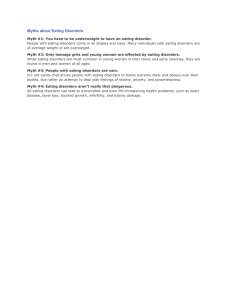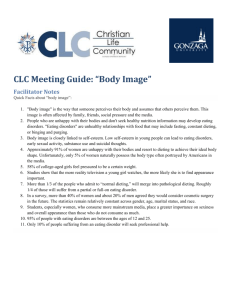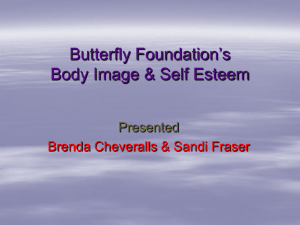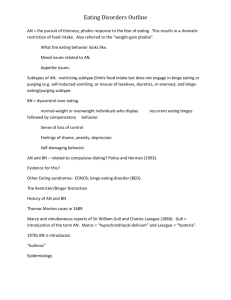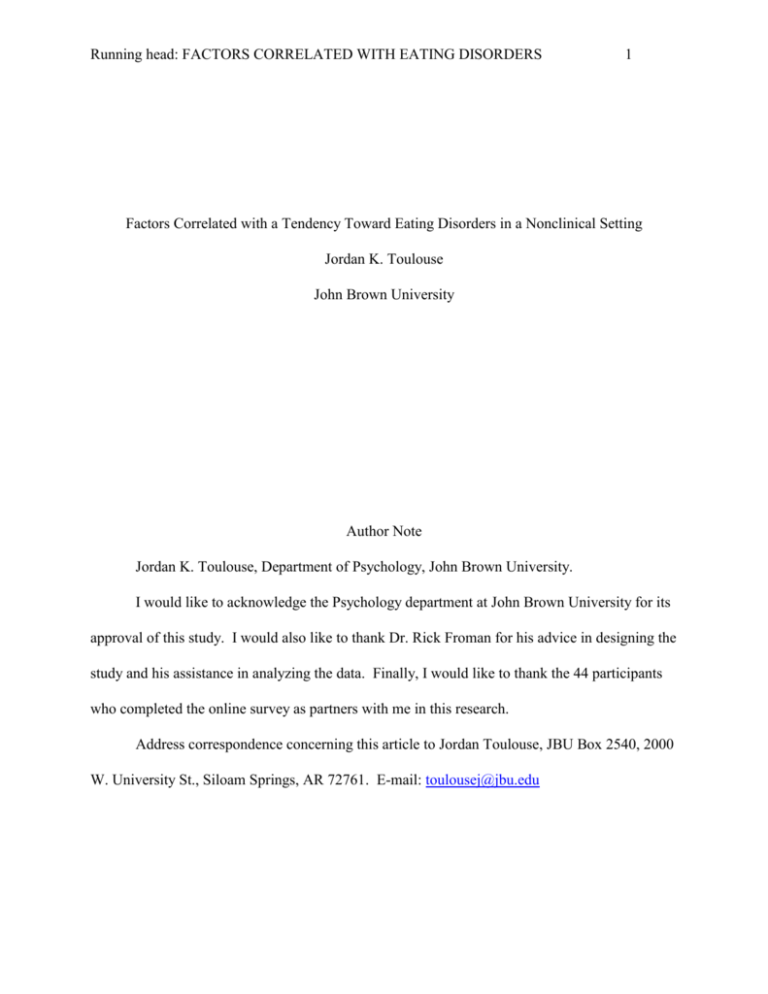
Running head: FACTORS CORRELATED WITH EATING DISORDERS
1
Factors Correlated with a Tendency Toward Eating Disorders in a Nonclinical Setting
Jordan K. Toulouse
John Brown University
Author Note
Jordan K. Toulouse, Department of Psychology, John Brown University.
I would like to acknowledge the Psychology department at John Brown University for its
approval of this study. I would also like to thank Dr. Rick Froman for his advice in designing the
study and his assistance in analyzing the data. Finally, I would like to thank the 44 participants
who completed the online survey as partners with me in this research.
Address correspondence concerning this article to Jordan Toulouse, JBU Box 2540, 2000
W. University St., Siloam Springs, AR 72761. E-mail: toulousej@jbu.edu
FACTORS CORRELATED WITH EATING DISORDERS
2
Abstract
Previous researchers have found that previous abuse, perceived pressure to be thin, and academic
pressure all related to the development of disordered eating behaviors. I sought to determine
whether these factors correlated with a tendency toward eating disorders at John Brown
University. The hypothesis was that women who had been exposed to abuse and perceived
pressure from others on campus to succeed and be thin are more likely to have a tendency toward
disordered eating. Analyses revealed no significant difference between abused and non-abused
participants. Pressures to be thin and to achieve academically correlated positively with overall
eating disorder scores. Future researchers might study samples from public universities and male
populations.
Keywords: physical abuse, sexual abuse, emotional abuse, verbal abuse, peer pressure,
eating attitudes, eating disorders
FACTORS CORRELATED WITH EATING DISORDERS
3
Factors Correlated with a Tendency toward Eating Disorders in a Nonclinical Setting
A great concern for many people in the United States is the rate at which Americans are
becoming obese; yet Americans continue to idealize an image of thinness. The desire to be thin
has become so strong that, according to the National Association of Anorexia Nervosa and
Associated Disorders (ANAD, 2007), eating disorders are endemic in the United States.
The three most common types of eating disorders are anorexia nervosa, bulimia nervosa,
and binge eating disorder (American Psychological Association, [APA], 2004, p. 1). People
suffering from anorexia nervosa usually have inaccurate body images, seeing themselves as being
overweight when they are often underweight in reality. Starvation, excessive exercise, and
substantial weight loss usually accompany this disease. Sufferers of bulimia nervosa generally
eat vast amounts of food before ridding their bodies of the food with excessive exercise,
vomiting, laxatives, or other methods of purging. Feelings of disgust and shame often
accompany binging episodes, and purging is the method by which sufferers seek to reduce these
negative emotions. People with binge eating disorder have episodes of extreme overeating
similar to those of bulimic individuals. However, sufferers from binge eating disorder do not use
unnatural methods to rid their bodies of the food they consume.
According to a 10 year study conducted by ANAD, these eating disorders typically
present in people by the age of 20 (ANAD, 2007). Approximately 43% of the participants in this
study reported their eating disorders between the ages of 16 and 20. It seems clear that the
college years are a period of life when eating disorders are not uncommon, especially among
women (APA, 2005).
Many researchers have attempted to determine factors that seem to influence the
occurrence of eating disorders. Some researchers have found that early childhood experiences
FACTORS CORRELATED WITH EATING DISORDERS
4
seem to relate to eating disorders later in life. For example, Treuer, Koperdak, Rozsa, and Furedi
(2005) used standardized procedures to conduct interviews and administer tests that indicated the
participants’ exposure to physical abuse and sexual abuse as well as the frequency with which
they exhibited disordered eating behaviors. Their sample included only those diagnosed with an
eating disorder based on the Diagnostic and Statistical Manual 4th Edition (DSM-IV; American
Psychiatric Association, 1994) criteria. The results showed that 29% of their sample had
experienced sexual abuse, and 57% had experienced physical abuse. In this particular study, they
discovered that the physical abuse had a negative impact on body image, and the sexual abuse
appeared to have no impact at all. They concluded that eating disorders correlated with both
sexual abuse and physical abuse, but that physical abuse was more related than expected.
Similarly, Wiederman, Sansone, and Sansone (1998) found substantially higher levels of
disordered eating behavior in women who indicated that they had personally witnessed violence
as a child or had experienced physical, sexual, or emotional abuse as children than women who
had not had those experiences.
In addition to early experiences, research has demonstrated that the pressures in a
person’s present environment influence eating behavior. One study involved only college
students and sought to determine the factors specific to students’ universities that contribute to
disordered eating behavior (Kashubeck, Walsh, & Crowl, 1994) using standardized testing to
examine students on two university campuses. At one school, a high emphasis on physical
appearance and characteristics that are more feminine both correlated positively with disordered
eating. At the other school, masculinity correlated negatively with disordered eating. Both
schools’ results demonstrated how pressure for high achievement related to eating disorders.
Previous research has identified a number of factors that may contribute to disordered
FACTORS CORRELATED WITH EATING DISORDERS
5
eating behavior. The previously mentioned study of separate university campuses by Kashubeck
et al. (1994) confirms that these factors may vary from location to location. With this in mind,
the purpose of the present study was to discover factors on a small Christian university campus
related to disordered eating behavior among students. The hypothesis is that students with higher
EDI survey scores will also reveal higher incidences of exposure to previous abuse, as well as
perceived pressures for appearance and academic achievement.
Method
Participants
A random sample of 100 female students was chosen from the undergraduate population
of John Brown University (JBU). Out of the 100 female students invited through campus email
to take the anonymous online survey, 44 actually completed the survey. The age range of actual
participants in the survey was between 18 and 26 years old, with an average age of 20.07 years.
Materials
The participants completed an online survey consisting of Garner and Olmstead’s (1984)
Eating Disorder Inventory (EDI) and supplemental questions that explored the factors
hypothesized to correlate with eating disorders. The instrument posed 70 questions and
contained demographic items sufficient to describe the sample.
Procedure
The random sample of female college students received an email explaining the survey
and providing a link to it. The students read the informed consent that explained that they would
indicate their consent by completing the survey.
FACTORS CORRELATED WITH EATING DISORDERS
6
Results
In order to test the hypothesis, the supplemental questions on the survey regarding
previous physical, sexual, or emotional abuse combined to form one score indicating any
previous abuse. A t test compared the abused participants with the non-abused participants for
the total survey score, comprised of the summed values of the responses for each participant.
Item scores were reversed so that the highest value for all items indicated the most disordered
response to the question. In addition to the t test comparing the total survey score, eight
additional t tests compared the scores of the two groups on each of the eight subscales of the EDI
(Bulimia, Maturity Fears, Interoceptive Awareness, Drive for Thinness, Body Dissatisfaction,
Perfectionism, Ineffectiveness, and Interpersonal Distrust). Pearson r correlations determined the
degree of each of the relationships between perceived pressures for academic success and
thinness with the total EDI survey score.
Forty students responded to all questions on the survey and contributed data to the test
comparing responses of abused and non-abused participants on the survey. A two-tailed t test
compared the overall scores of the abused and non-abused students. The t test revealed no
significant difference between the abused and nonabused participants’ scores, t (38) = .41, p =
.68.
Eight additional two-tailed t-tests compared the abused and non-abused participants on
the eight subscales comprising the EDI. The t-test results revealed no significant difference
between the abused and non-abused groups’ survey scores for any subscale: Bulimia, t (42) = .35,
p = .73; Maturity Fears, t (42) = .47, p = .64; Interoceptive Awareness, t (41) = 1.71, p = .09;
Drive for Thinness, t (41) = .27, p = .79; Ineffectiveness, t (41) = .60, p =.55; Body
Dissatisfaction, t (41) = .005, p = .996; Perfectionism, t (40) = 1.61, p = .12; Interpersonal
FACTORS CORRELATED WITH EATING DISORDERS
7
Distrust, t (42) = .93, p = .36.
A Pearson r correlation determined the correlations between pressures from others on
campus to be thin and to achieve academic success with the EDI survey scores. Forty
participants responded to the item on the survey asking about perceived pressure from others on
campus to be thin. The data analysis revealed a significant moderate positive correlation
between participants’ perceived pressure from others on campus to be thin and EDI survey score,
r (38) = .65, p<.001 (see Figure 1). The r2 value for this correlation was .43, indicating that the
variance in perceived pressure to be thin accounts for approximately 43% of the variance in total
EDI survey scores. The same number of participants responded to the item on the survey asking
about perceived pressure from others on campus to achieve academic success. The data analysis
revealed only a weak significant positive correlation between participants’ perceived pressure
from others on campus to achieve academic success and EDI survey score, r (40) = .34, p = .03
(see Figure 2). The r2 value of .12 for this correlation indicates that perceived pressure for
academic success accounts for only approximately 12% of the variance in total EDI survey score.
Discussion
A series of two-tailed t tests found no significant differences between abused and
nonabused participants with regard to overall survey scores and scores on the eight subscales of
the EDI. This is contradictory to what previous research in this area found.
Treuer et al. (2005) found that those who had been physical abused had a significantly
more negative body image compared to those who had not been physically abused. They found
that both physical and sexual abuse positively correlated with the frequency with which
participants exhibited disordered eating behavior. Their study differed from the present study in
several ways, especially in the population from which they selected their sample. The sample for
FACTORS CORRELATED WITH EATING DISORDERS
8
their study included only participants who received eating disorder diagnoses prior to the study.
Because the use of the EDI questions in the present study was primarily for comparison instead
of for diagnosis, it is not possible to determine whether any of the participants in the current
study had eating behaviors as severe as those in Treuer et al.’s study. It is a fair assumption that
their diagnosed participants exhibited much more severe eating behaviors than the present
sample due to the increased frequency of previous abuse.
The study by Weiderman et al. (1998) was similar to the present study; however, it
involved women who were not necessarily college students and who visited a gynecologist
regularly. In the study, they asked women if they had ever experienced the various forms of
abuse and if they had ever participated in disordered eating behavior. The significant difference
between abused and nonabused participants was perhaps a result of the fact that researchers
defined disordered eating behavior as one or more attempts by participants to starve themselves,
purge, or take laxatives in order to get rid of food. In the present study, 64 questions analyzed
the degree of disordered eating behavior on a 7-point scale, so that participants who performed
disordered eating behaviors only occasionally did not receive high scores. Perhaps the lowscoring participants of the present study would have been considered disordered in the
Weiderman et al. study, possibly leading to significant results that fail to take into account the
degree of disordered behavior.
The present study on the JBU campus showed that the EDI survey scores of the
participants correlated positively with perceived pressure from others on campus to be thin. This
is consistent with the research of Kashubeck et al. (1994), who found similar results at one of the
campuses in their study. The relationship between perceived pressure to be thin and higher
survey scores may seem obvious, but this is still something to which the JBU community should
FACTORS CORRELATED WITH EATING DISORDERS
9
be sensitive. It is possible for the community of JBU and similar communities to offer services
and adopt attitudes that can help to reduce negative responses in women who feel such pressure.
The current research also revealed a weak positive correlation between EDI survey scores
and perceived pressure from others on campus to achieve academically, a result that Kashubeck
et al. (1994) found on both campuses in their study. It seems that pressure from others still
influences students on the JBU campus. Because academic pressure is an ongoing characteristic
of university life, this result is not surprising and may not have much of a direct influence on
eating behaviors. It is also possible that academic pressures lead students to miss meals, overeat
during stressful times, or fail to devote time to exercise. All of these responses to pressure are
maladaptive and could lead to feelings and behaviors related to eating disorders.
Although the community of JBU has no control over various forms of abuse that happen
before a student enrolls or the pressure from outside sources (e.g., media) to be thin, it does have
the opportunity to equip students to respond appropriately and healthily to these issues.
Although there have been temporary support groups on campus for women who have
experienced sexual assault, in addition to opportunities for counseling offered free of charge, no
permanent support groups are available at this time for those who have experienced physical,
sexual, or emotional abuse. The JBU community could use these groups to reach out to women
who have been victims of abuse. Out of the 44 women who completed the study, 25% reported
previous abuse. It would be wise for the JBU community to discover the needs of these women
and look for additional ways to provide for them. In addition to this, the community should train
students to cope appropriately with academic pressure, perhaps by providing stress and time
management courses. Students should refrain from making discriminatory comments about
others that may cause some students to feel pressure regarding appearance. The university
FACTORS CORRELATED WITH EATING DISORDERS
10
should offer courses or support groups dealing with body image or nutrition. An anonymous
online moderated discussion board might be an option for students who wish to discuss these
issues without revealing their identities.
Future researchers might give the same survey from the present study to a secular
university in order to test for the same hypotheses, as well as to determine the difference between
JBU responses and the responses of a larger secular university. It is possible that the Christian
beliefs that JBU emphasizes had an effect on the research. For example, students may cope
better with previous abuse and perceived pressure because their faith provides them with coping
techniques such as prayer or meditation. Students who believe that God personally created them
may have more appreciation and respect for their bodies. Students may also have been less than
honest in responses to questions about sensitive issues, because Christians consider physical,
emotional, and sexual violence as sins. Students who inappropriately place blame for these
experiences on themselves may not be comfortable with admitting being involved in abusive
situations. Participants may also have been less likely to report previous abuse or maladaptive
behaviors because of perceived pressure from the Christian community to forgive others and put
the past behind them.
Future researchers should provide definitions for physical, sexual, and emotional abuse,
because the students who indicated abuse might have actually experienced different levels of
abuse. Subsequent studies might also seek to determine the effects of abuse on eating behaviors
for men. However, it might first be beneficial to study the differences between men and women
in their opinions on what constitutes abuse. A study with this research question in mind might
provide scenarios to both males and females, asking them to decide whether each situation is
abusive. One potential problem with such a study is the sensitivity of the issues it would present
FACTORS CORRELATED WITH EATING DISORDERS
11
to participants.
Regardless of the fact that most of the results of this study were statistically insignificant,
this research provided valuable information to JBU regarding its own community. The results of
this study were not consistent with some of the previous research mentioned, but it is important
to realize that JBU is a unique community that specifically stands out from other communities
because of its emphasis on Christianity. The JBU community should continue to take into
account the diverse lives of its students as it considers how to equip them to respond healthily
and appropriately to their abusive experiences and to the pressures they currently perceive on
campus.
FACTORS CORRELATED WITH EATING DISORDERS
12
References
American Psychiatric Association. (1994). Diagnostic and statistical manual of mental disorders
(4th ed.). Washington, DC: Author.
American Psychological Association. (2004). APA Help Center: Eating disorders. Retrieved
from http://www.apahelpcenter.org/articles/pdf.php?id=9.
American Psychological Association. (2005). APA Help Center: Facts and statistics. Retrieved
from http://www.apahelpcenter.org/articles/topic.php?id=6#Eating%20Disorders.
Garner, D. M. & Olmsted, M. P. (1984). Eating disorder inventory. Los Angeles, CA: Western
Psychological Services.
Kashubeck, S., Walsh, A., & Crowl, A. (1994). College atmosphere and eating disorders.
Journal of Counseling and Development, 72, 640-645.
National Association of Anorexia Nervosa and Associated Disorders (2004). Facts about eating
disorders. Retrieved from http://www.anad.org/22385/index.html.
Treuer, T., Koperdak, M., Rozsa, S., & Furedi, J. (2005). The impact of physical and sexual
abuse on body image in eating disorders. European Eating Disorders Review, 13, 106111. doi: 10.1002/erv.616
Weiderman, M., Sansone, R., & Sansone, L. (1998). Disordered eating and perceptions of
childhood abuse among women in a primary care setting. Psychology of Women
Quarterly, 22, 493-497.
FACTORS CORRELATED WITH EATING DISORDERS
Figure 1. Significant moderate positive correlation between pressure from others on campus to
be thin and total survey score.
13
FACTORS CORRELATED WITH EATING DISORDERS
Figure 2. Significant but weak positive correlation between pressure from others on campus to
achieve academic success and total survey score.
14





